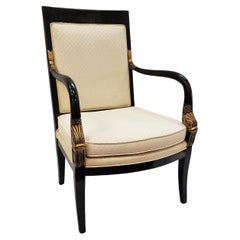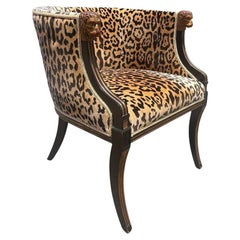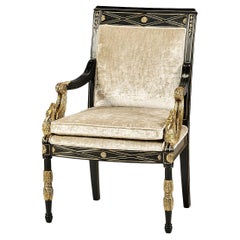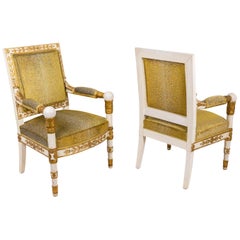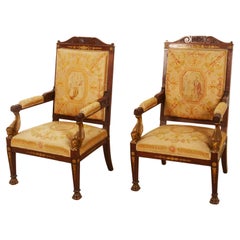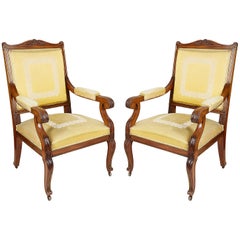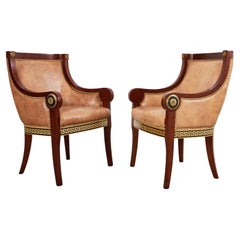Empire Style Armchair
Vintage 1960s Armchairs
Textile, Wood
Early 20th Century French Empire Armchairs
Fabric, Wood
Antique Late 19th Century American Empire Armchairs
Mahogany
Antique Early 1900s European Armchairs
Fabric, Wood, Giltwood
21st Century and Contemporary Vietnamese Empire Armchairs
Velvet, Wood
Mid-20th Century Empire Armchairs
Wood
Antique 1870s French Empire Armchairs
Tapestry, Walnut
Antique 19th Century French Empire Revival Armchairs
Mahogany
21st Century and Contemporary Empire Armchairs
Metal, Brass
Vintage 1940s American Empire Armchairs
Wood
Antique Late 19th Century American Empire Armchairs
Linen, Wood
Vintage 1920s Danish Empire Armchairs
Mahogany
Vintage 1940s French Armchairs
20th Century Empire Armchairs
Wood
Antique 1890s French Empire Armchairs
Fabric, Mahogany
Antique 1890s French Empire Armchairs
Bronze
Antique Early 1900s French Empire Armchairs
Bronze
Vintage 1950s European Empire Revival Armchairs
Bronze
Late 20th Century American Regency Armchairs
Upholstery, Cherry
Antique 19th Century French Empire Armchairs
Mahogany
Vintage 1980s French Empire Armchairs
Leather, Birch
Mid-20th Century Empire Armchairs
Leather, Wood, Giltwood
Antique Early 19th Century European Empire Chairs
Bronze
Antique Late 19th Century Empire Revival Armchairs
Brass, Ormolu
20th Century Empire Armchairs
Fabric, Wood, Beech
Antique 19th Century Armchairs
Fabric, Wood
Antique 19th Century Russian Empire Armchairs
Mahogany
20th Century French Empire Armchairs
Linen, Upholstery, Mahogany
20th Century French Empire Armchairs
Linen, Upholstery, Mahogany
Vintage 1970s French Empire Armchairs
Gold
21st Century and Contemporary American Empire Armchairs
Hardwood, Upholstery, Paint
Antique 19th Century French Empire Armchairs
Walnut
Antique 19th Century French Empire Armchairs
Ormolu
Antique 19th Century French Empire Armchairs
Wood
Antique 19th Century French Empire Armchairs
Bronze
Antique Mid-19th Century French Empire Armchairs
Bronze
Antique Late 19th Century French Empire Armchairs
Fruitwood
Mid-20th Century French Empire Armchairs
Wood
20th Century French Napoleon III Armchairs
Wood
Antique Late 19th Century European Empire Armchairs
Bronze, Ormolu
Antique 17th Century North American Empire Armchairs
Fabric, Wood
2010s Italian Armchairs
Gold Leaf
Antique 1870s French Empire Armchairs
Silk, Walnut, Paint
Vintage 1950s Belgian Empire Armchairs
Fabric, Wood
Antique Early 19th Century French Empire Armchairs
Cherry
Antique 19th Century Empire Armchairs
Bronze
Antique Mid-19th Century Victorian Armchairs
Mahogany
20th Century French Empire Armchairs
Wood
Late 20th Century French Armchairs
Mahogany
Antique 1830s French Empire Bergere Chairs
Mahogany
Antique 19th Century French Empire Armchairs
Wood, Mahogany
Antique Early 19th Century French Empire Armchairs
Silk, Mahogany
Antique 19th Century French Empire Armchairs
Wood, Giltwood
20th Century French Empire Armchairs
Wood
Vintage 1950s French Empire Revival Armchairs
Walnut
Antique 19th Century French Empire Armchairs
Velvet, Giltwood
Early 20th Century Empire Armchairs
Leather, Wood
Late 20th Century Empire Armchairs
Ultrasuede, Wicker, Mahogany
- 1
Empire Style Armchair For Sale on 1stDibs
How Much is a Empire Style Armchair?
Finding the Right Armchairs for You
Armchairs have run the gamut from prestige to ease and everything in between, and everyone has an antique or vintage armchair that they love.
Long before industrial mass production democratized seating, armchairs conveyed status and power.
In ancient Egypt, the commoners took stools, while in early Greece, ceremonial chairs of carved marble were designated for nobility. But the high-backed early thrones of yore, elevated and ornate, were merely grandiose iterations of today’s armchairs.
Modern-day armchairs, built with functionality and comfort in mind, are now central to tasks throughout your home. Formal dining armchairs support your guests at a table for a cheery feast, a good drafting chair with a deep seat is parked in front of an easel where you create art and, elsewhere, an ergonomic wonder of sorts positions you at the desk for your 9 to 5.
When placed under just the right lamp where you can lounge comfortably, both elbows resting on the padded supports on each side of you, an upholstered armchair — or a rattan armchair for your light-suffused sunroom — can be the sanctuary where you’ll read for hours.
If you’re in the mood for company, your velvet chesterfield armchair is a place to relax and be part of the conversation that swirls around you. Maybe the dialogue is about the beloved Papa Bear chair, a mid-century modern masterpiece from Danish carpenter and furniture maker Hans Wegner, and the wingback’s strong association with the concept of cozying up by the fireplace, which we can trace back to its origins in 1600s-era England, when the seat’s distinctive arm protrusions protected the sitter from the heat of the period’s large fireplaces.
If the fireside armchair chat involves spirited comparisons, your companions will likely probe the merits of antique and vintage armchairs such as Queen Anne armchairs, Victorian armchairs or even Louis XVI armchairs, as well as the pros and cons of restoration versus conservation.
Everyone seems to have a favorite armchair and most people will be all too willing to talk about their beloved design. Whether that’s the unique Favela chair by Brazilian sibling furniture designers Fernando and Humberto Campana, who repurposed everyday objects to provocative effect; or Marcel Breuer’s futuristic tubular metal Wassily lounge chair; the functionality-first LC series from Charlotte Perriand, Le Corbusier and Pierre Jeanneret; or the Eames lounge chair of the mid-1950s created by Charles and Ray Eames, there is an iconic armchair for everyone and every purpose. Find yours on 1stDibs right now.
- 1stDibs ExpertApril 5, 2022The Classical world is primarily what influenced French Empire furniture. Greek and Roman motifs appear on many pieces. In addition, the opulence of Egyptian furniture inspired furniture makers active during the period. On 1stDibs, shop a range of French Empire furniture.
- 1stDibs ExpertOctober 7, 2024The difference between the Biedermeier and Empire styles lies largely in the characteristics most commonly associated with them. Although these two furniture styles both emerged around 1815 and persisted into the 1840s, pieces associated with them have differing features. Developed in France, the Empire style emphasized ornamentation and grandeur, with furniture makers often drawing inspiration from ancient Roman forms. Dark woods were the most commonly used materials of the style. In Germany and other parts of Central Europe, artisans working in the Biedermeier style favored simplicity. They also tended to source woods locally and chose light finishes for their pieces. Explore a selection of Biedermeier and Empire furniture on 1stDibs.
Read More
All the Furniture in This Organic Modern Soho Loft Can Be Yours
Andrianna Shamaris has filled her epic new home with pieces of her own design.
20 Inviting Dining Rooms Perfectly Arranged for Entertaining
Top interior designers show — and tell — us how to create delectable spaces for hosting dinner parties.
Nobody Puts This Sunny Sofa in a Corner
With its plush cushions, cane details and dazzlingly colorful back, it’s inviting from every angle.
The 21 Most Popular Mid-Century Modern Chairs
You know the designs, now get the stories about how they came to be.
Fred Rigby’s Modular Seating Can Be Configured in So Many Handy Ways
The plush Cove Slipper 2.5 Seater sofa is just one of many convenient combinations from the London-based maker.
This Chubby-Chic Quilted Stool Stands on Its Own Two Feet
Sam Klemick's cool stool is edgy, cozy and environmentally sustainable all at once.
Is Lionel Jadot the Willy Wonka of Upcycled Belgian Design?
From his massive collaborative workshop in a former paper factory, the designer concocts funky furniture from disused materials, as well as luxe hotel interiors like the new Mix Brussels.
Rock Your Cares Away on This Sunny Hand-Crocheted Swing
The boho-chic Enchanted Forest Swing, handmade by marginalized women from Turkey and Syria, is uplifting in every way.
